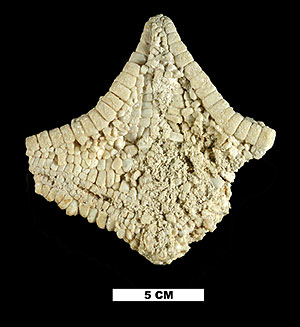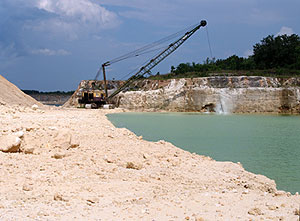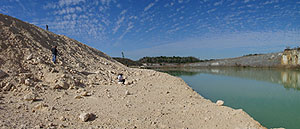
Photo courtesy of the Florida Museum's invertebrate paleontology collection
Imagine trying to piece together a picture of marine species living 40 million years ago based on the flimsiest of evidence: an assortment of small pieces of calcite no longer than half an inch.
Invertebrate paleontologists who work with sea stars, commonly known as starfish, face this difficulty often.
A recent Journal of Paleontology study co-authored by Florida Museum of Natural History paleontologist Roger Portell challenges researchers to consider how they make systematic interpretations from this sketchy fossil record. It also describes three new species of sea star from two new genera (both family Goniasteridae) based on partial specimens housed at the Florida Museum.
Intact specimens of ancient sea stars are rare. Paleontologists are far more likely to find individual ossicles, the pieces of calcite that together form the sea star’s internal skeleton. These ossicles are usually all that is left after their skin decomposes and biological and physical processes scatter their remains.
“The majority of the fossil record for sea stars is based on disarticulated ossicles,” Portell said. “Trying to make determinations of where they belong systematically is incredibly difficult.”
During his 26 years in the field, Portell has found only three relatively intact goniasterid sea stars in Florida. The fossils all came from the north central portion of the state. During that same time, he has found thousands of isolated ossicles.

Photo by Sean Roberts
The July 2009 study describes Oyenaster oblidus, Ocalaster timucum and Ocalaster seloyi.
Sea stars have hundreds of ossicles that change as the organism grows, and are difficult to place morphologically once the organism disintegrates. Still, paleontologists have described dozens of species of ancient goniasterid sea stars based solely on the evidence of fossil ossicles. They frequently rely on marginal ossicles, which are larger and form the sea star’s outer edges.
The Journal of Paleontology study questions this practice.
Portell and lead author Daniel Blake, from the University of Illinois, suggest researchers need to take modern goniasterid sea stars, dissolve their skin and let the ossicles disarticulate to see whether they can determine where all the parts go and whether they can identify the genera and species, Portell said.
Modern sea stars are highly diverse. Some are carnivorous predators that feed on coral polyps. Others are deposit feeders in ocean mud. The carnivorous Crown of Thorns (Acanthaster plancican) can wipe out an entire coral reef within a year or two. Another sea star, Pisaster ochraceus, inspired the concept of keystone species based on the ecological effects of its predation of sea urchins and mussels.
The bulk of macrofauna in the deep sea are from the phylum Echinodermata, which includes sea stars. Echinoderms as a whole dominated ocean systems during the Paleozoic era, 542 million to 251 million years ago. The sea star family Goniasteridae emerged during the middle Jurassic period, some 170 million years ago. The goniasterid specimens described in the paper come from the Eocene Epoch and are 40 million to 35 million years old.
“A number of fossil goniasterid species have been pigeonholed into modern genera based on similar form of isolated ossicles,” Portell said. “But those ossicles don’t give you an idea what those whole animals would have looked like.

Photo by Sean Roberts
Having an articulated specimen makes the task much easier, Portell said. But even then, fossils are missing key morphological traits. When the skin comes off, the specimen loses its spines and small appendages known as pedicellariae. Both are important in modern taxonomy for identifying species.
One of the specimens used in the Journal of Paleontology study had one complete ray (or arm), two partial rays and part of the central disk. That made it easier to make comparisons with other whole body fossils and modern genera and species.
But discovering such fossils is hit or miss, sometimes literally. One of Portell’s partial specimens was uncovered by a student who hit it with a hammer twice before deciding to check whether it might be important.
That fossil was just one good swing away from turning into a bucketful of pieces. Instead, it became a key specimen for the study.
Learn more about the Invertebrate Paleontology Collection at the Florida Museum.